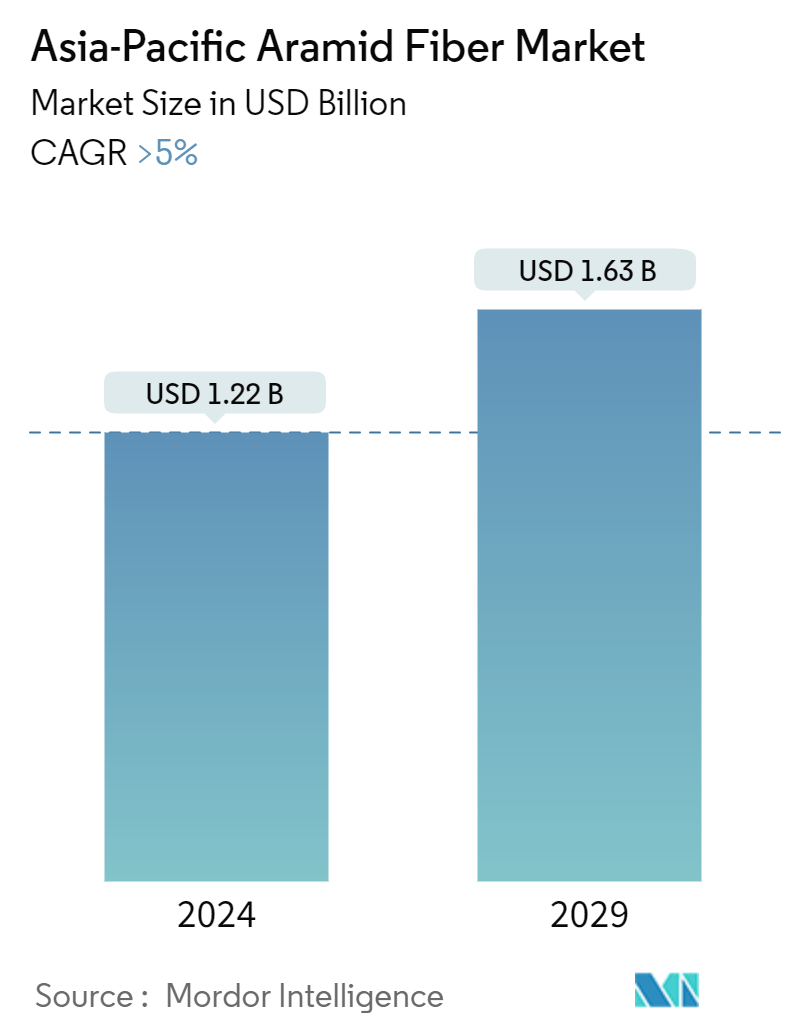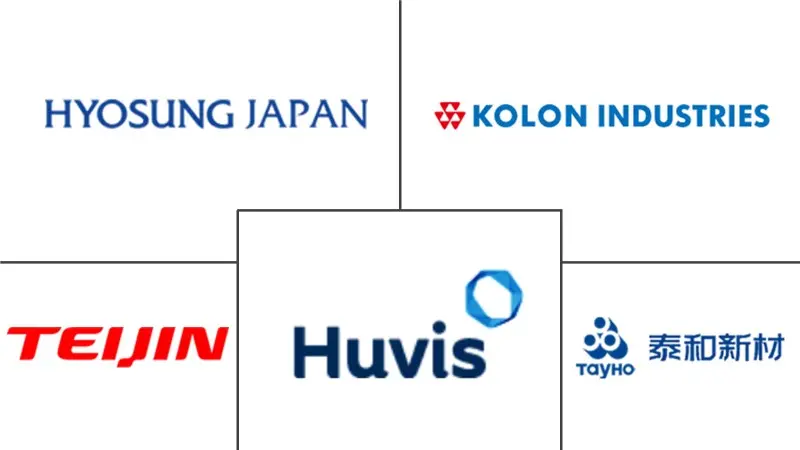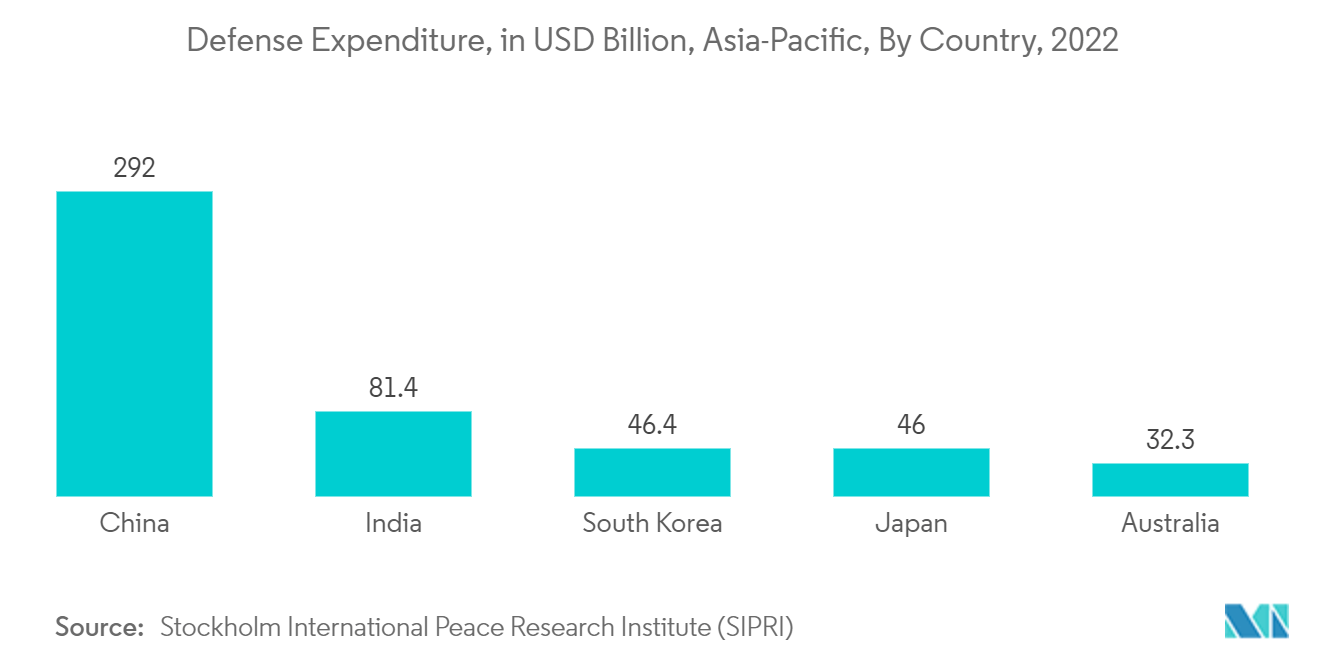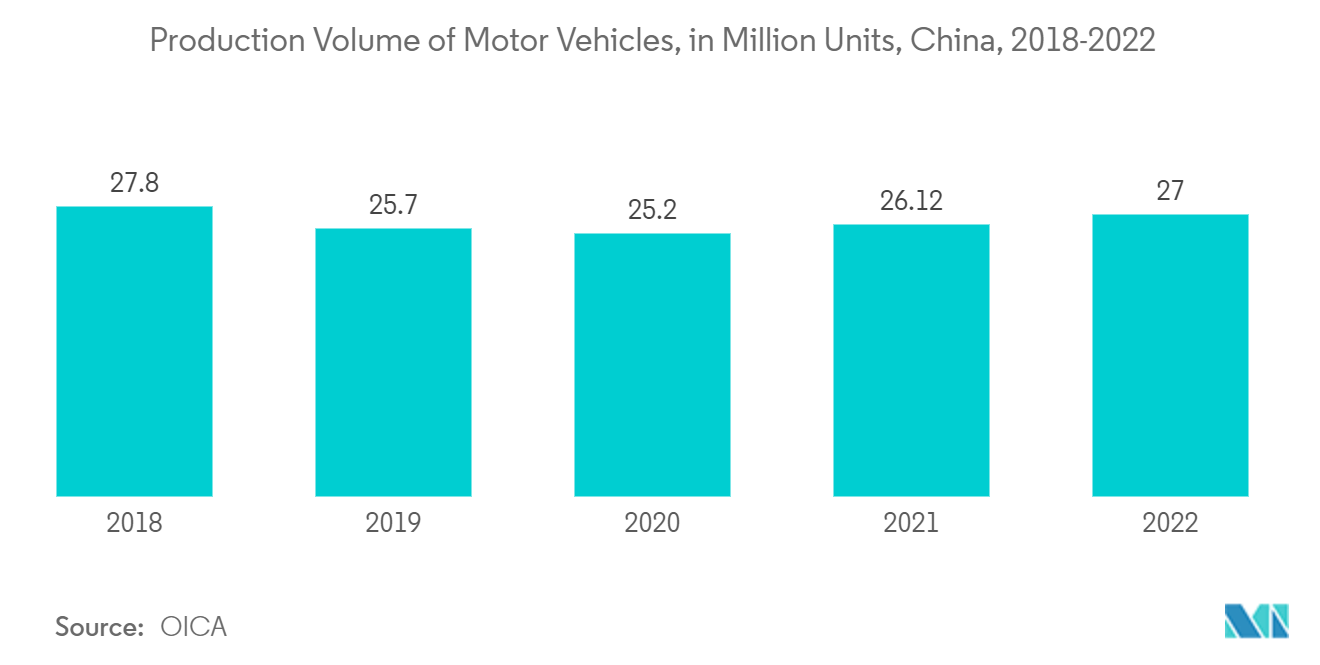Asia-Pacific Aramid Fibers Market Size

| Study Period | 2019 - 2029 |
| Base Year For Estimation | 2023 |
| Market Size (2024) | USD 1.22 Billion |
| Market Size (2029) | USD 1.63 Billion |
| CAGR (2024 - 2029) | 5.00 % |
| Market Concentration | High |
Major Players
*Disclaimer: Major Players sorted in no particular order |
Asia-Pacific Aramid Fibers Market Analysis
The Asia-Pacific Aramid Fiber Market size is estimated at USD 1.22 billion in 2024, and is expected to reach USD 1.63 billion by 2029, growing at a CAGR of greater than 5% during the forecast period (2024-2029).
In Asia-Pacific, countries like China and India were worst hit by the COVID pandemic, negatively affecting the market. Automotive and electronic manufacturing activities were temporarily halted due to the pandemic, which had decreased the usage of aramid fibers. However, the market recovered well after the restrictions were lifted. The market recovered significantly, owing to the rise in consumption of aramid fibers in the Aerospace and, defense, and automotive industries.
- The increase in demand for lightweight materials in the automotive industry, the rising defense expenditure of India and China, and the increase in the usage of aramid fibers as a potential substitute for steel materials are expected to drive the market.
- The availability of better alternatives for aramid fibers and the non-biodegradable nature of aramid fibers are hindering market growth.
- The growing demand from the aerospace sector and advancements in aramid materials manufacturing technology are expected to create opportunities for the market during the forecast period.
- China is expected to dominate the market due to the rising demand for aramid fibers in the aerospace and defense, automotive end-user industries. It is also expected to register the highest CAGR during the forecast period.
Asia-Pacific Aramid Fibers Market Trends
Aerospace and Defense End-User Industry to Dominated the Market
- Aramids are used for components and structural applications in all aircraft and spacecraft, ranging from hot air balloons and gliders to fighter planes, passenger airliners, and space shuttles. The aramid fibers are generally used in wing assemblies, helicopter rotor blades, seat propellers, and enclosures for instruments and internal parts.
- Every year, the aerospace industry uses a higher proportion of aramid fibers in constructing each new generation of aircraft due to the provision of an all-weather operation of commercial aviation and enhanced vision systems. Moreover, characteristics such as temperature stability and durability will further fuel the growth of the aerospace composites market over the coming years.
- China and India are the region's largest markets for aerospace and defense industries. China is expected to be the fastest-growing country in the civil aviation sector. The government is expected to witness a 9.5% y-o-y passenger growth rate, which will require an additional 6,800 aircraft to add to the existing commercial fleet. This increase is expected to drive the demand for aramid fibers in the country.
- Boeing and Airbus are the most prominent civil aircraft manufacturers in China. To decrease the dominance of these companies Commercial Aviation Corp of China (COMAC) started to manufacture civil aircraft in the country. In September 2022, the company delivered its first homemade passenger jet in China. Furthermore, the reach of the annual production capacity of Commercial Aviation Corp of China (COMAC) is around 150 domestically produced C919 planes in five years.
- Furthermore, the production volume of helicopters is increasing in India with the addition of new helicopter manufacturing plants. For instance, in 2023, Prime Minister Narendra Modi inaugurated the helicopter manufacturing factory of Hindustan Aeronautics Limited (HAL) in Karnataka. The facility will produce around 30 Light Utility Helicopters (LUHs) annually. It can be enhanced to 60 and then 90 per year in a phased manner.
- Similarly, the defense expenditure is increasing in India. According to the Stockholm International Peace Research Institute (SIPRI), in 2022, the defense expenditure in India is registered at USD 81.4 billion, as compared to USD 76 billion expenditure in the previous year. Thus the increase in defense expenditure will drive the market for aramid fibers in the country.
- Thus, the growth in the aerospace and defense industries is expected to drive the market for aramid fibers in the region.

China to Dominate the Market
- China is one of the significant markets for Aramid Fibers in the region. Aramid fibers are used in various end-user industries, such as aerospace and defense. Automotive, electric and electronics, and sporting goods. In China, the automotive and aerospace sectors registered significant market growth, thereby driving the market for aramid fibers in the country.
- China is the largest automotive vehicle manufacturer in the region. According to OICA (The Organisation Internationale des Constructeurs d'Automobiles), automotive vehicle production in China reached a total of 27.02 million units in 2022, an increase of 3% over the previous year for the same period.
- Moreover, the automobile industry in the country is witnessing switching trends as the consumer inclination toward battery-operated vehicles is on the higher side. Furthermore, the government of China estimates a 20% penetration rate of electric vehicle production by 2025. This is reflected in the electric vehicle sales trend in the country, which went to a record-breaking high in 2022. As per the China Passenger Car Association, the government sold 5.67 million EVs and plug-ins in 2022, touching almost double the sales figures achieved in 2021.
- China is the largest market for airplane OEMs in the region. Boeing and Airbus are the most prominent civil aircraft manufacturers in China. To decrease the dominance of these companies, the Commercial Aviation Corp of China (COMAC) started to manufacture civil aircraft in the country.
- Furthermore, to decrease the dominance of these companies, the Commercial Aviation Corp of China (COMAC) started to manufacture civil aircraft in the country. In September 2022, the company delivered its first homemade passenger jet in China. Furthermore, the annual production capacity of Commercial Aviation Corp of China (COMAC) is around 150 domestically produced C919 planes in five years.
- Overall, the growth of industries such as automotive and aerospace are likely to drive the market for aramid fibers in the country during the forecast period.

Asia-Pacific Aramid Fibers Industry Overview
The Asia-Pacific aramid fiber market is consolidated in nature. Some of the key players in the market (not in any particular order) include Huvis Corp, HYOSUNG JAPAN, Kolon Industries Inc., Teijin Aramid, and Yantai Tayho Advanced Materials Co., Ltd.
Asia-Pacific Aramid Fibers Market Leaders
-
Huvis Corp
-
Kolon Industries Inc.
-
Teijin Aramid
-
Yantai Tayho Advanced Materials Co.,Ltd.
-
HYOSUNG JAPAN
*Disclaimer: Major Players sorted in no particular order

Asia-Pacific Aramid Fibers Market News
The recent developments pertaining to the major players in the market are being covered in the complete study.
Asia-Pacific Aramid Fibers Market Report - Table of Contents
1. INTRODUCTION
- 1.1 Study Assumptions
- 1.2 Scope of the Study
2. RESEARCH METHODOLOGY
3. EXECUTIVE SUMMARY
4. MARKET DYNAMICS
-
4.1 Drivers
- 4.1.1 The Increase in Demand for Light Weight Materials in Automotive Industry
- 4.1.2 The Rising Defense Expenditure of India and China
- 4.1.3 The Increase in Usage of Aramid Fibers as a Potential Substitute for Steel Materials
-
4.2 Restraints
- 4.2.1 The Availability of Better Alternatives For Aramid Fibers
- 4.2.2 Non-Biodegradable Nature of Aramid Fibers
- 4.3 Industry Value-Chain Analysis
-
4.4 Porter's Five Forces Analysis
- 4.4.1 Bargaining Power of Suppliers
- 4.4.2 Bargaining Power of Buyers
- 4.4.3 Threat of New Entrants
- 4.4.4 Threat of Substitute Products and Services
- 4.4.5 Degree of Competition
5. MARKET SEGMENTATION (Market Size in Value)
-
5.1 Product Type
- 5.1.1 Para-aramid
- 5.1.2 Meta-aramid
-
5.2 End-user Industry
- 5.2.1 Aerospace and Defense
- 5.2.2 Automotive
- 5.2.3 Electrical and Electronics
- 5.2.4 Sporting Goods
- 5.2.5 Other End-user Industries (Oil & Gas, Telecommunication, etc.)
-
5.3 By Geography
- 5.3.1 Asia-Pacific
- 5.3.1.1 China
- 5.3.1.2 India
- 5.3.1.3 Japan
- 5.3.1.4 South Korea
- 5.3.1.5 Malaysia
- 5.3.1.6 Thailand
- 5.3.1.7 Indonesia
- 5.3.1.8 Vietnam
- 5.3.1.9 Rest of Asia-Pacific
6. COMPETITIVE LANDSCAPE
- 6.1 Mergers and Acquisitions, Joint Ventures, Collaborations, and Agreements
- 6.2 Market Share (%)**/Ranking Analysis
- 6.3 Strategies Adopted by Leading Players
-
6.4 Company Profiles
- 6.4.1 China National Bluestar (Group) Co. Ltd
- 6.4.2 Dupont
- 6.4.3 Hebei Silicon Valley Chemical Co. Ltd.
- 6.4.4 Huvis Corp
- 6.4.5 HYOSUNG JAPAN
- 6.4.6 KERMEL
- 6.4.7 Kolon Industries Inc.
- 6.4.8 Shanghai J&S New Materials Co.,ltd
- 6.4.9 Teijin Aramid
- 6.4.10 TORAY INDUSTRIES, INC.
- 6.4.11 X-FIPER New Material Co. Ltd.
- 6.4.12 Yantai Tayho Advanced Materials Co.,Ltd.
- *List Not Exhaustive
7. MARKET OPPORTUNITIES AND FUTURE TRENDS
- 7.1 Growing Demand from the Aerospace Sector
- 7.2 Advancements in Aramid Materials Manufacturing Technology
Asia-Pacific Aramid Fibers Industry Segmentation
Aramid fiber is an artificial, high-performance organic fiber that is manufactured from aromatic polyamides. The key characteristics of aramid fiber include high strength, good resistance to heat, abrasion, and organic solvents, non-conductivity, and low flammability. It is mainly used for applications such as composites, ballistics, optical fiber cables, protective clothing against heat and chemicals, and others.
The Asia-Pacific aramid fiber market is segmented by product type, end-user industry, and geography. By product type, the market is segmented into para-aramid and meta-aramid. By end-user industry, the market is segmented into aerospace and defense, automotive, electrical and electronics, sporting goods, and other end-user industries (oil & gas, telecommunications, etc.). The report also covers the market size and forecasts for the Asia-Pacific aramid fiber market for 8 major countries. Each segment's market sizing and forecasts are based on value (USD).
| Product Type | Para-aramid | |
| Meta-aramid | ||
| End-user Industry | Aerospace and Defense | |
| Automotive | ||
| Electrical and Electronics | ||
| Sporting Goods | ||
| Other End-user Industries (Oil & Gas, Telecommunication, etc.) | ||
| By Geography | Asia-Pacific | China |
| India | ||
| Japan | ||
| South Korea | ||
| Malaysia | ||
| Thailand | ||
| Indonesia | ||
| Vietnam | ||
| Rest of Asia-Pacific |
Asia-Pacific Aramid Fibers Market Research FAQs
How big is the Asia-Pacific Aramid Fiber Market?
The Asia-Pacific Aramid Fiber Market size is expected to reach USD 1.22 billion in 2024 and grow at a CAGR of greater than 5% to reach USD 1.63 billion by 2029.
What is the current Asia-Pacific Aramid Fiber Market size?
In 2024, the Asia-Pacific Aramid Fiber Market size is expected to reach USD 1.22 billion.
Who are the key players in Asia-Pacific Aramid Fiber Market?
Huvis Corp, Kolon Industries Inc., Teijin Aramid, Yantai Tayho Advanced Materials Co.,Ltd. and HYOSUNG JAPAN are the major companies operating in the Asia-Pacific Aramid Fiber Market.
What years does this Asia-Pacific Aramid Fiber Market cover, and what was the market size in 2023?
In 2023, the Asia-Pacific Aramid Fiber Market size was estimated at USD 1.16 billion. The report covers the Asia-Pacific Aramid Fiber Market historical market size for years: 2019, 2020, 2021, 2022 and 2023. The report also forecasts the Asia-Pacific Aramid Fiber Market size for years: 2024, 2025, 2026, 2027, 2028 and 2029.
APAC Aramid Fiber Industry Report
Statistics for the 2024 APAC Aramid Fiber market share, size and revenue growth rate, created by Mordor Intelligence™ Industry Reports. APAC Aramid Fiber analysis includes a market forecast outlook 2029 and historical overview. Get a sample of this industry analysis as a free report PDF download.



